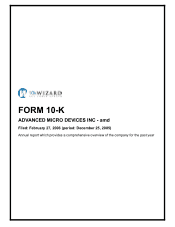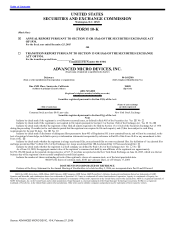AMD 2005 Annual Report Download - page 9
Download and view the complete annual report
Please find page 9 of the 2005 AMD annual report below. You can navigate through the pages in the report by either clicking on the pages listed below, or by using the keyword search tool below to find specific information within the annual report.
Table of Contents
process technologies have resulted in significant advances in microprocessor performance over the past two decades. We market our processors based on overall
performance, which is a function of both architecture and clock speed.
The microprocessor market is characterized by short product life cycles and migration to ever-higher-performance microprocessors. To compete
successfully in this market, we must transition to new process technologies at a fast pace and offer higher-performance microprocessors in significantly greater
volumes. We also must achieve manufacturing yield and volume goals in order to sell microprocessors at competitive prices.
Our microprocessors currently are designed with both 32-bit and 64-bit processing capabilities. The bit rating of a microprocessor generally denotes the
largest size of numerical data that a microprocessor can handle. For approximately the last ten years, microprocessors have had 32-bit computing capabilities.
While 32-bit processors have historically been sufficient, we believe that they will face challenges as new data and memory-intensive consumer and enterprise
software applications gain popularity. Microprocessors with 64-bit processing capabilities enable systems to have greater performance by allowing software
applications and operating systems to access more memory. From applications for multimedia and gaming, to grid computing and extensive enterprise databases,
we believe the demand for 64-bit computing will increase.
Improvements in the prices and performance characteristics of microprocessors as well as in software operating systems and applications, and computer
components and systems generally have combined to increase the demand for microprocessors over time. The greatest demand for our microprocessors today is
from PC manufacturers.
Microprocessor Products
We currently offer microprocessor products for desktop and mobile PCs, servers and workstations. Our microprocessors are based on the x86 instruction
set architecture. In addition, we design them based on a superscalar reduced instruction set computer, or RISC, architecture. RISC architecture allows
microprocessors to perform fewer types of computer instructions thereby allowing the microprocessor to operate at a higher speed. We also design our
microprocessors to be compatible with operating system software such as Microsoft® Windows®, Linux, NetWare®, Solaris and UNIX.
Desktop PCs. Our microprocessors for desktop PCs consist of the following tiered product brands: AMD Athlon ™ 64 FX, AMD Athlon 64 ™ and AMD
Sempron™ processors. We designed the AMD Athlon 64 FX processor specifically for gamers, PC enthusiasts and digital content creators who require
processors that can perform graphic-intensive tasks. We designed our AMD Athlon 64 processors for enterprises and sophisticated PC users that seek to access
large amounts of data and memory. For value-conscious consumers of desktop and notebook PCs, we offer the AMD Sempron microprocessors, which we
designed to provide core computing needs at affordable prices. AMD Athlon 64 and AMD Athlon 64 FX processors are based on the AMD64 technology
platform, which extends the industry-standard x86 instruction set architecture to 64-bit computing. We designed our AMD Athlon 64 processors to allow
simultaneous 32-bit and 64-bit computing, enabling users to protect their information technology investments by continuing to use their 32-bit software
applications while implementing 64-bit applications on the timetable of their choice.
In May 2005, we introduced our AMD Athlon 64 X2 dual-core processors for desktop PCs. These processors contain two CPU cores on one
semiconductor die, which enables them to execute more operations simultaneously during each clock cycle. These processors offer users improved overall
performance compared to single-core processors as well as improved performance-per-watt. The performance advantages of AMD Athlon 64 X2 dual-core
processors are especially evident in multi-tasking environments where they can enable operating systems to prioritize and manage tasks from multiple software
applications simultaneously. For example, users are able to simultaneously download audio files such as MP3s, burn a CD, check and write e-mail, edit a digital
photo and run virus protection without compromising the performance of their PC. AMD Athlon 64 X2 dual-core
4
Source: ADVANCED MICRO DEVIC, 10-K, February 27, 2006






















